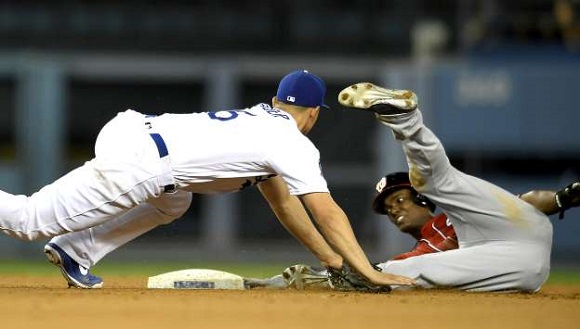
I must admit, I’m a real sucker for stolen bases. This is especially true in H2H each category leagues, where I have seen countless matchups come down to who wins stolen bases. I’m not the “draft Billy Hamilton way too early then become disappointed when he can’t hit the baseball AGAIN” type of sucker though. I’m more of a “piecing together a lot of guys that will chip in 10-15 stolen bases but will also help considerably in other areas” type of sucker. With stolen base numbers on the decline, they are harder to find. Which in turn means that stolen bases are becoming more valuable. This is no secret, but with power and home runs being more accessible than before, stolen bases are being really undervalued.
One of the problems with trying to add stolen bases is that most guys that steal bases are either already owned, don’t play every day, or don’t help you/significantly hurt you elsewhere. Or maybe a wonderful combination! This week, I’ve got a guy for you that hopefully does not meet the above criteria: Michael A. Taylor (26.6% owned in ESPN, 38% owned in Yahoo), outfielder for the Washington Nationals.
Tale of the Tape:
2017: .271/.320/.486 55 R, 19 HR, 53 RBI, 17-for-24 in SB in 432 PA
2018: .220/.289/.354, 13 R, 2 HR, 8 RBI, 9-for-9 in SB in 90 PA
Currently 57th on Razzball Player Rater and 37th on ESPN Player Rater
The Good:
Obviously, his speed. His 9 stolen bases are tied with Dee Gordon for the 2nd most in the MLB. Not only does he have 9 stolen bases, but he is a perfect 9-for-9, which should ensure he will see many more opportunities. Speaking of opportunities, the Nationals lead the league in stolen base attempts with 1.33 per game. Additionally, it appears as though Taylor and teammate Trea Turner have the green light until further notice. “According to Manager Dave Martinez, those two are on their own on the bases unless he specifically signals for them to not steal.” This is excellent news for Taylor, whose aggressiveness on the base paths should continue to yield plenty of stolen bases. Speed has never been the concern for Taylor, while his ability to make contact and get on base has limited his value in the past. But as his 2017 numbers show, he was able to hit .270+, while recording 19 HR and swiping 17 bases. This shows that Taylor is not just a one dimensional fantasy asset and can actually help in multiple categories. His bleak .220 average and .289 OBP are not what you want to see, but he has been coming around at the plate lately.
Last 7: .316/.409/.737, 5 R, 2 HR, 5 RBI, 3-for-3 in SB in 22 PA
The Bad:
His ability to put the bat on the ball. Taylor has struck out in a third (33.3%) of all his plate appearances in 2018. Pretty similar to last year where he struck out 31.7% of the time, and in line with his career strikeout rate of 31.9%. You cannot trust someone to steal bases if they strikeout nearly a third of the time they come up to bat. His swinging strike rate of 14.4% is a leading cause. He may have hit .271 last year, but it required a very fortunate .363 BABIP to do so. His BABIP is currently sitting at .320, and the accompanying .220 average seems to fit his hitting profile. Taylor also typically hits in the bottom third of the Nationals lineup which typically doesn’t bode well for counting stats. He has been hitting 6th a lot recently, but that is due to injuries of players such as Anthony Rendon and Adam Eaton. Once they are back, he will likely be pushed back down to the bottom of the order. Additionally, once members of the offense return manager Dave Martinez may not give him as long of a leash on the base paths.
The Verdict:
Michael A. Taylor has the speed to be an elite stolen base threat and could finish the season with 30/40 SB if he gets on base enough. “If he gets on base enough” is unfortunately THE deciding factor for a speedster like Taylor. It is not encouraging to see someone whose value derives from being on base strikeout nearly a third of their appearances. However, he was able to put together a great season last year while striking out 31.7% of the time so what is stopping him from doing so again? He still managed to hit .271 while adding 19 home runs and 17 stolen bases. So while his speed may be the coveted asset, he actually contains a surprising amount of pop and could crack 20/20 this year. It is much easier to get behind someone with low contact/high strikeout rates that contributes speed and power, instead of just speed or power. And there are still many players that fall under that category that are rostered and maintain fantasy value. Though injured and off to a slow start, the Nationals have a top tier offense which should help Taylor’s counting stats. Washington has gone from attempting .84 SB/game in 2017 to a league leading 1.33 this season, so expect to see an active Taylor on the base paths even when some players return. The risk is known with Taylor, but the reward could far outweigh that risk in the coming months. So give him a look and add him if you have space, because his ownership rates could spike if he continues to heat up at the dish.


